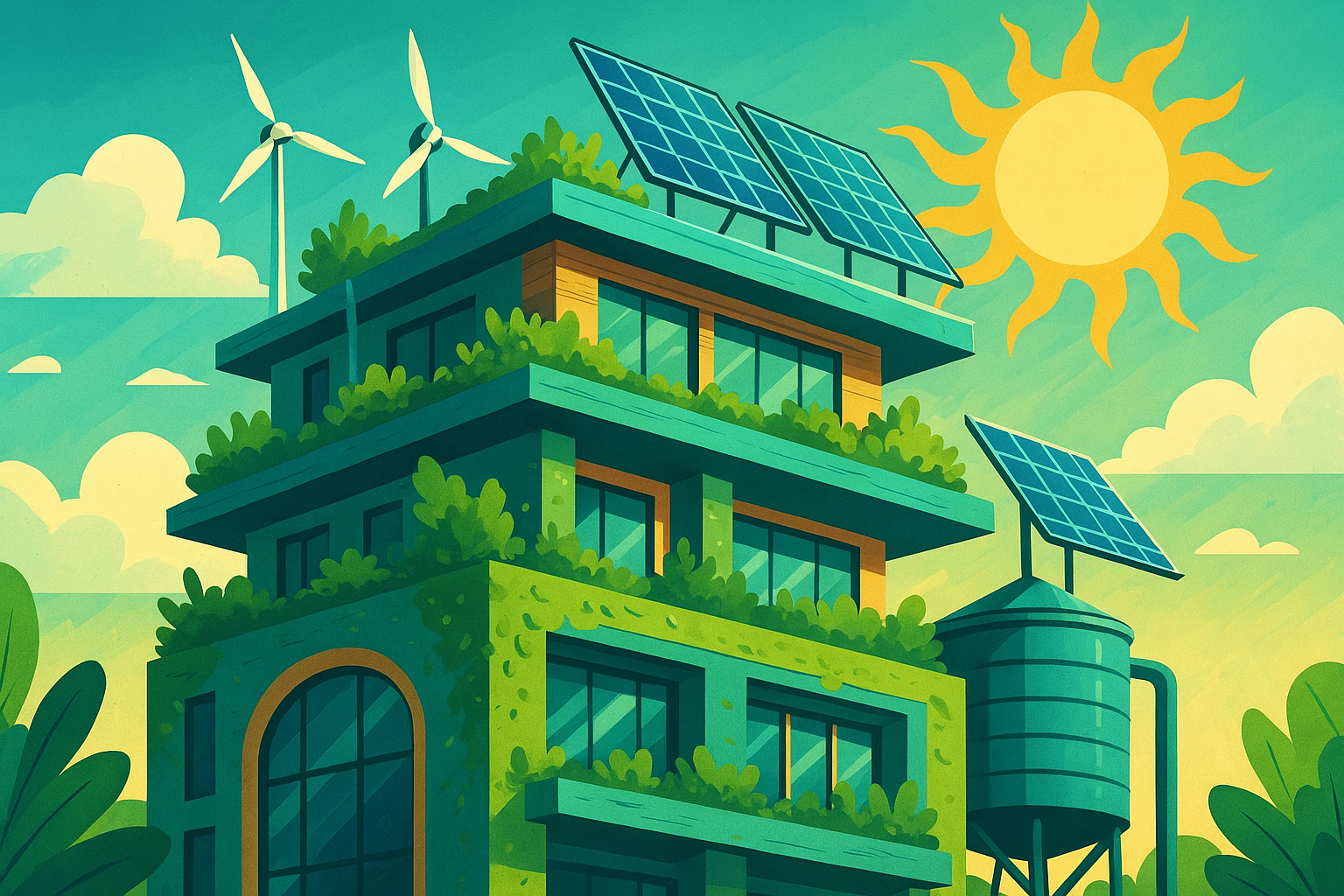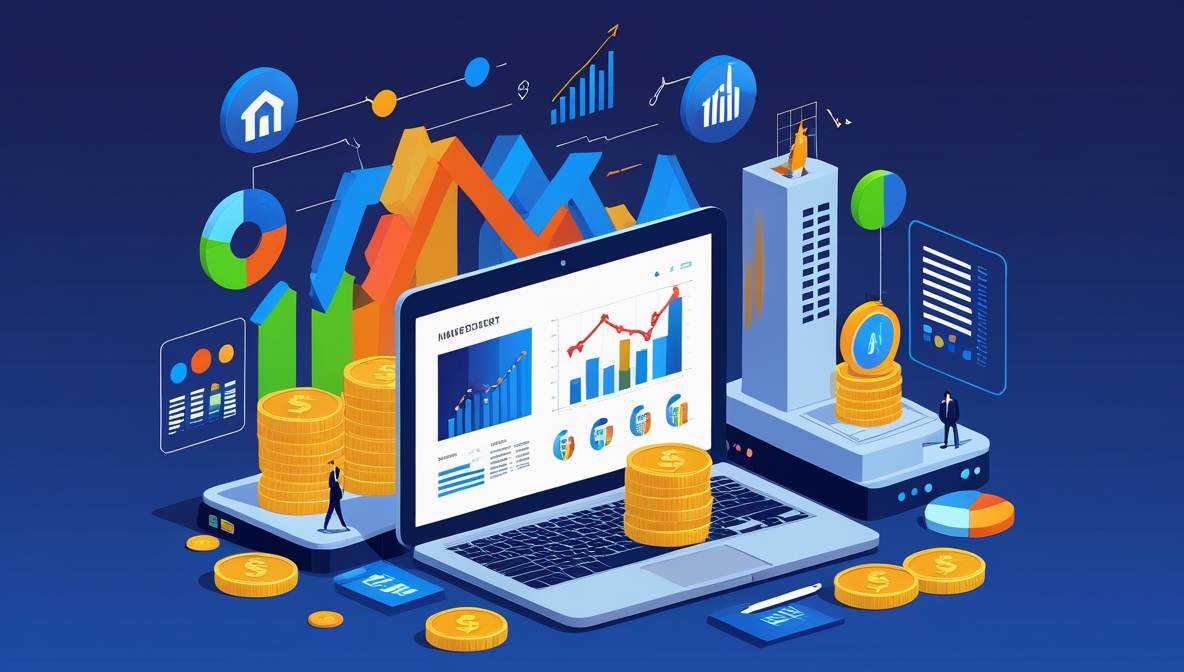Remember when “green building” just meant adding a few plants in the lobby? Yeah… not anymore. Today, sustainability is reshaping the entire construction industry—from the materials we choose to the way we design, build, and even think about buildings. Whether you’re a builder, architect, or just someone who wants their project to be a little kinder to the planet, this guide breaks down the biggest trends making eco-friendly construction the new normal (and honestly, way cooler than concrete gray).
The Rise of Eco-Friendly Materials
Let’s be real—concrete and steel have had their moment. Solid? Yes. Functional? Always. But green? Not exactly.
In a world where sustainability is becoming more than a buzzword, builders, designers, and architects are rethinking what materials make the cut.
And guess what? Eco-friendly doesn’t mean boring anymore.
Today’s sustainable building materials are not just good for the planet—they’re smart, stylish, and surprisingly high-performing. You’re not just doing something good; you’re doing something better.
Bamboo: Nature’s Overachiever
If you think bamboo is only for cute pandas and zen gardens, think again.
Bamboo is one of the fastest-growing plants on the planet, and it’s quickly becoming a superstar in sustainable construction.
It’s lightweight, super strong, and refreshingly versatile. You can use it for flooring, walls, structural support—even scaffolding in some parts of the world.
And bonus: it looks great.
Because it grows so quickly, bamboo is incredibly renewable. That means less impact on forests and a much smaller carbon footprint.
So if you’re trying to balance beauty with sustainability, bamboo’s got your back.
Some design-forward firms (and yes, companies like CEESCO who consult on structural systems) are already using bamboo in creative ways. From wall panels to decking, it’s popping up in more projects than ever—and for good reason.
Recycled Materials: Old is the New New
Here’s a fun idea—what if your next project used less new stuff?
Recycled building materials are having a moment, and they’re bringing character, savings, and serious green cred to the table.
We’re talking recycled wood, reclaimed metal, repurposed brick, and even insulation made from denim scraps. (Yes, you read that right—your old jeans could now be keeping walls warm.)
Using recycled materials reduces landfill waste, conserves raw resources, and lowers emissions from manufacturing. It’s a triple win.
And don’t worry—this isn’t about filling your house with junkyard finds. Most reclaimed materials today are carefully treated and repurposed to meet modern safety and quality standards. They’re old with a new attitude.
The key is working with people who know where to source the good stuff and how to work it into your design. That’s where having the right team (like CEESCO or other sustainability-minded partners) can really help. They’ve been part of projects that blend recycled charm with structural integrity—without looking like a Pinterest experiment gone wrong.
Low-Impact Concrete: The Gray Area Goes Green
Concrete is everywhere. Like, literally everywhere. But it’s also a major contributor to global CO₂ emissions. So how do we fix that?
Enter low-impact concrete.
Innovators are now developing versions of concrete that use less cement, or even alternative binders like fly ash or slag, to reduce emissions.
Some types even absorb CO₂ over time—turning the problem into part of the solution.
Then there’s pervious concrete, which lets water pass through instead of creating runoff. It helps recharge groundwater and reduces strain on city drainage systems. Functional and eco-friendly? That’s what we like to see.
Using greener concrete doesn’t mean sacrificing strength or durability. It just means being smarter about the mix. And if that sounds complicated, don’t worry—it’s the kind of thing an experienced engineer (maybe someone at CEESCO) can walk you through without giving you a headache.
Insulation That Doesn’t Cost the Earth
Traditional insulation is often full of chemicals and hard-to-recycle materials. But sustainable insulation? That’s where things get a lot cozier.
Materials like sheep’s wool, hemp, cellulose, and even recycled cotton are now being used to keep buildings warm or cool without the environmental guilt.
These materials are breathable, renewable, and surprisingly effective. Plus, they tend to be safer to handle and install—no hazmat suits required.
Some of them even help regulate humidity and improve indoor air quality. That’s not just good for the planet—it’s good for your lungs too.
More and more builders are swapping out the old itchy pink stuff for insulation that feels more like a warm hug from Mother Nature.
And honestly, once you’ve experienced the difference, there’s no going back.
The Future Looks Bright (and Bio-Based)
We’re also seeing the rise of biomaterials like mycelium (yep, mushrooms) and algae-based plastics. They might sound like science fiction, but they’re already making their way into building products.
These materials are grown, not manufactured—meaning their carbon footprint is a fraction of traditional options. They’re biodegradable, renewable, and weirdly exciting.
Imagine a future where your building materials grow back faster than grass after rain. That’s where we’re headed—and the future looks green, soft, and slightly spongy.
Build Smarter, Not Just Stronger
The rise of eco-friendly materials isn’t just a trend—it’s a shift in how we think about construction.
It’s about building spaces that work with nature instead of against it.
It’s about using fewer resources without sacrificing quality, comfort, or style.
And it’s about making choices today that future generations won’t have to fix.
If you’re curious about how to incorporate more sustainable materials into your next project, talk to your architect, your builder—or a structural engineering team like CEESCO that’s already knee-deep in this green evolution.
After all, construction isn’t just about what you build. It’s about how you build it. And these days, green is definitely the new gray.
Solar, Rainwater, and Smart Everything
There was a time when a “high-tech home” meant automatic garage doors and maybe a motion-sensor porch light.
Now? We’re talking homes and buildings that sip sunshine, harvest rain, and practically run themselves.
Welcome to the age of smart, sustainable construction—where your roof generates power, your walls manage temperature, and your water tank is smarter than your coffee machine.
This is more than just a green trend. It’s a smarter way to build—and it’s surprisingly doable.
Soak Up the Sun: Solar’s Time to Shine
Solar panels aren’t just for off-grid cabins or ultra-modern mansions anymore. They’ve gone mainstream—and they’re here to stay.
You’ve probably seen them on homes, office buildings, schools, and even bus stops. Why? Because solar power just makes sense.
You’re using a free, unlimited energy source (thanks, sun!) to power everything from lights to laptops. Plus, with better battery storage and smart inverters, solar energy can be stored and used even when the sun isn’t shining.
But solar isn’t just about panels anymore. There are solar shingles, solar windows, and even solar bricks—building materials that double as mini power stations.
And while solar tech has gotten smarter, it’s also gotten more affordable. Many regions offer tax breaks, rebates, or net metering programs that make the investment worth it.
If you’re not sure how to get started, teams like CEESCO often work with clients and developers to assess solar feasibility and integrate it into the design phase—making the whole process much smoother than you’d expect.
Rain, Rain, Don’t Go Away (We Need You)
Let’s talk about rainwater—not just the stuff that ruins your hairdo, but the kind that could be watering your garden and flushing your toilet.
Rainwater harvesting is one of the simplest, most practical ways to add sustainability to a building—and you don’t need a high-tech setup to start.
At its core, it’s just about collecting rain from your roof, filtering it, and using it for non-potable needs like landscaping, irrigation, or even cooling systems.
You’d be amazed how much water you can collect from a small rooftop. And during dry seasons or water restrictions, this backup source can really come in handy.
Some systems are basic—just a tank and a filter. Others are connected to your home’s plumbing with sensors, pumps, and smart controls.
Whatever setup you choose, you’re saving money, reducing demand on municipal water, and being a responsible Earth citizen. Gold star for you.
If you’re building new or retrofitting, engineers or consultants (like the folks at CEESCO) can help design systems that meet local codes and actually work for your space—so you don’t end up with a giant tank that does nothing but collect mosquitoes.
Welcome to the Smart Side
Let’s be honest—who doesn’t want their building to be a little smarter?
Smart systems are no longer a luxury. They’re fast becoming standard tools for saving energy, improving comfort, and making life easier.
We’re talking:
- Smart thermostats that learn your schedule
- Lighting systems that adjust to natural light levels
- Smart blinds, smart plugs, and even smart toilets (yes, those exist—and they’re kind of amazing)
These technologies don’t just look cool. They actually help buildings perform better.
By automatically adjusting lighting, heating, cooling, and appliance use, smart systems can cut energy usage by 20–30% without you lifting a finger. That’s better for your utility bill and the planet.
The best part? Most smart systems are modular and scalable. Start with a smart thermostat today. Add sensors, controls, and monitoring tools later.
You don’t need to go full Iron Man from day one.
And when you’re managing a bigger project or commercial space, smart systems become even more powerful. They can track energy usage in real time, detect equipment failures before they happen, and even automate maintenance alerts.
If that sounds overwhelming, don’t worry—you’re not alone. Engineers and consultants who focus on sustainable systems (yes, even CEESCO) help simplify the process and make sure all the tech actually works together.
Build Smarter, Live Better
Here’s the deal: solar power, rainwater harvesting, and smart systems aren’t just nice extras. They’re fast becoming essentials for buildings that want to be efficient, resilient, and future-ready.
And the best part? You don’t have to be a tech genius or eco-warrior to make it happen.
You just need to start asking the right questions, explore your options, and bring in the right people to help.
Want your next building to sip sunshine, reuse water, and manage itself? That’s not science fiction anymore—it’s totally possible.
Professionals like CEESCO are already helping developers and owners do exactly that. Quietly, effectively, and without making it feel like rocket science.
Because building smarter isn’t just about adding gadgets. It’s about designing systems that think ahead, so you don’t have to stress later.
Cool Projects Around the World Doing It Right
Let’s be honest—sustainable construction used to have a reputation for being a little… well, boring.
Gray walls, recycled carpet, and light bulbs that barely lit the room. But times have changed.
Today, green buildings are stealing the spotlight. They’re bold, innovative, and frankly, just cool. They’re proving that you don’t have to choose between saving the planet and building something stunning.
So if you’re looking for inspiration (or just want to geek out over amazing design), here are some real-world projects doing sustainability right.
1. The Edge – Amsterdam, Netherlands

Let’s start with a building so smart it might be smarter than most of us.
The Edge is often called the greenest office building in the world—and for good reason.
It’s powered by solar energy, collects rainwater, and is packed with sensors that manage everything from lighting to desk usage.
Even the coffee machines are connected to your schedule. (Yes, really.)
It uses 70% less electricity than similar buildings, and it’s designed to make people feel better while using fewer resources.
Imagine walking into work and the lights adjust to your preferences, your desk is assigned based on your calendar, and your energy use is already optimized. That’s not the future—it’s just Tuesday at The Edge.
For projects like this, having a smart engineering and design team from the start is key. That’s the kind of role consultants like CEESCO can play: making sure innovation and functionality grow together.
2. Bosco Verticale – Milan, Italy

Who says skyscrapers can’t have forests?
Bosco Verticale, which means “Vertical Forest,” is a pair of residential towers that look like they’ve been swallowed by nature—in the best possible way.
Each balcony holds trees, shrubs, and plants that improve air quality, reduce heat, and provide homes for birds and bugs.
Over 900 trees are planted across both towers, making them a living, breathing part of the city.
Besides being beautiful, the greenery provides natural insulation and soundproofing. It’s basically nature’s own building material doing what it does best.
The design shows what happens when architects, engineers, and sustainability experts collaborate from the start—something that firms like CEESCO support on a smaller, regional scale.
It’s a perfect example of how nature and urban life don’t have to fight—they can actually thrive together.
3. The Bullitt Center – Seattle, USA

Meet the building that dares to call itself “the greenest commercial building in the world.”
The Bullitt Center is a six-story office building that operates completely off-grid. It generates its own electricity, captures its own water, and even composts waste on-site.
One of the coolest parts? The “irresistible staircase.” It’s designed so beautifully (and placed right in the center of the building) that everyone wants to use it instead of the elevator.
Everything inside is sourced sustainably—even the wood used is FSC-certified. It’s built to last 250 years—a true shift away from the disposable mindset.
This project proves that being eco-friendly doesn’t have to be temporary, trendy, or too complicated. It’s about thoughtful design, smart engineering, and long-term thinking.
And while you may not be building the next Bullitt Center, you can apply these ideas to your own projects—especially with the right support team.
4. CopenHill – Copenhagen, Denmark

Now for something completely wild: a power plant with a ski slope on the roof.
Yes, you read that right.
CopenHill is a waste-to-energy plant that converts trash into electricity—and doubles as a public park, climbing wall, and ski run.
On top of the building, you’ll find green space, trees, and locals casually skiing down the artificial slope with one of the best city views in Europe.
This is green innovation at its boldest. It combines utility, sustainability, and community benefit into one crazy-awesome concept.
CopenHill proves that sustainable infrastructure doesn’t have to be hidden or boring. It can be a destination, an experience, and a source of pride.
Even if your project isn’t ski-slope material, it’s a reminder to think bigger—and bring creative minds to the table from the beginning.
(CEESCO, for example, often works with clients to turn early design ideas into smart, practical plans—sometimes with surprisingly cool results.)
What You Can Learn From These Projects
You might not be designing a vertical forest or building your office on top of a ski run—but you can apply the same mindset.
Every project, no matter the size, has the potential to be smarter, greener, and more inspiring.
Start by asking:
- Can we use renewable energy here?
- Can we reuse water or reduce waste?
- How do we make this space healthier and more connected to nature?
You’ll be surprised how much is possible when you challenge the default and bring in the right experts.
Build Like You Mean It
The coolest sustainable projects in the world didn’t happen by accident. They were designed with purpose, built with care, and supported by teams that understood the mission.
And the best part? These buildings aren’t just environmentally friendly—they’re beautiful, functional, and loved by the people who use them.
So whether you’re working on a home, a school, or a full-blown commercial development, remember: green can be bold. Sustainability can be exciting.
And with the right mindset—and maybe a little help from a team like CEESCO—you can build something that’s not just good for the planet, but unforgettable for everyone who walks through the door.
How Small Changes Make a Big Impact
When people hear “sustainable construction,” they often imagine massive solar farms, futuristic green towers, or budgets that would make a banker sweat.
But here’s a little secret—you don’t have to build the next eco-skyscraper to make a difference.
Sometimes, it’s the tiny tweaks that add up to big results.
Think less “green revolution,” more “green ripple effect.”
One change at a time—one smart choice at a time—and suddenly, you’re building smarter, cleaner, and better than you thought possible.
Let’s look at a few easy wins that can make your project more sustainable without making your life more complicated.
Switch That Switch
Lighting is one of the easiest places to start if you want to go green without going broke.
Old-school bulbs? Toss ‘em. LED lighting is where it’s at—longer lifespan, lower energy use, and way fewer heat emissions.
You’ll instantly cut electricity bills, and over time, that adds up to real money (and fewer maintenance headaches).
Go a step further and install motion sensors or daylight sensors in common areas.
No more lights blazing all night in empty hallways. It’s efficient and makes you feel like your building’s paying attention.
Smart lighting systems are surprisingly affordable now, and the ROI is faster than most people expect.
You can even start small—maybe one room, then scale from there.
If you’re not sure where to begin, a consultant or engineer (like the folks at CEESCO) can help you figure out the best setup for your space.
They’re pretty great at turning “I just want to save power” into “Wow, this building is actually smart.”
Low-Flow = High Impact
Plumbing isn’t the most glamorous part of a project, but it’s one of the sneakiest places to save resources.
Low-flow fixtures—like toilets, showerheads, and faucets—can reduce water use by up to 50% without anyone noticing a difference in performance.
Less water used means less water wasted. And if you’re paying for water (which, let’s face it, most of us are), that’s a win-win.
Install aerators in faucets. Use dual-flush toilets. Consider waterless urinals in high-traffic spaces.
These are not groundbreaking inventions—they’re simple swaps that pack a punch.
And if you’re already planning a renovation, it’s the perfect time to make the switch. No extra hassle—just better results.
Bonus points if you pair this with a rainwater harvesting system or greywater reuse setup.
That might sound fancy, but in many places, it’s becoming the new standard—and it doesn’t have to be overwhelming when you bring in the right partners.
Insulate Like You Mean It
A well-insulated building is like a thermos—it keeps the temperature just right without needing constant input.
That means less heating in the winter, less cooling in the summer, and way fewer climate-control complaints.
Using eco-friendly insulation—like sheep’s wool, recycled denim, or cellulose—can improve energy efficiency without adding weird chemicals to your walls.
Plus, your building gets quieter, cozier, and more comfortable to live or work in.
(And if you’ve ever had to take a Zoom call next to a noisy HVAC unit, you know that’s a gift.)
Even small insulation upgrades, like sealing gaps around windows or doors, make a surprising difference.
A lot of people ignore insulation because it’s hidden—but trust us, your utility bill definitely notices.
If you’re not sure what makes sense for your structure, that’s where teams like CEESCO quietly shine. They can guide you to materials and methods that match your goals and budget—no stress, just solutions.
Materials Matter (Even the Little Ones)
You don’t need to rebuild the world to make it better—just be thoughtful about what you put into it.
Choosing locally sourced, low-VOC, or recycled materials reduces emissions, supports your community, and makes your space healthier to be in.
Something as simple as picking paint with low toxins or choosing cabinets made from sustainably harvested wood can help create a cleaner, safer environment.
Plus, telling your friends that your floors are made of reclaimed barn wood? Pretty great conversation starter.
Want to take it further? Ask suppliers for Environmental Product Declarations (EPDs) or green certifications. These aren’t just badges—they show that the materials you’re using meet real environmental standards.
You don’t have to check every box on day one. Just picking one or two better options can shift your project in the right direction.
Start Somewhere—Then Keep Going
You don’t have to do it all at once. You don’t need to be perfect.
But making a few smart, sustainable choices early in your project can create a ripple effect that goes far beyond the jobsite.
Better lighting. Smarter plumbing. Healthier materials. It all adds up.
And the best part? These changes usually make things more efficient, more comfortable, and more affordable over time.
It’s not about doing everything—it’s about doing something. Start where you can, learn as you go, and celebrate the small wins.
And if you ever feel stuck or overwhelmed by options, it helps to bring in a team who’s seen it all.
Companies like CEESCO have helped clients turn basic projects into smart, efficient, future-ready spaces—with minimal drama and maximum results.
So the next time someone says, “It’s just a lightbulb,” you can smile and say, “Exactly—and it’s already saving me money.”
Because when it comes to building greener, small is mighty.




